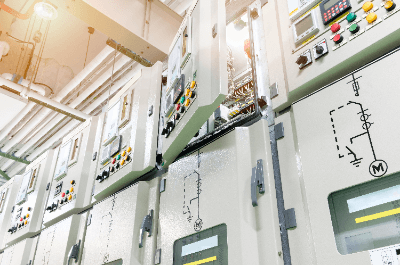What Is a Control Panel?
 A control panel is a box in which electrical equipment for controlling industrial production lines and machinery is concentrated.
A control panel is a box in which electrical equipment for controlling industrial production lines and machinery is concentrated.
It is generally manufactured in the form of a robust metal box, and is baked or powder coated to prevent rust, corrosion, and salt damage.
Uses of Control Panels
Control panels are used in all aspects of industry.
The following are applications of control panels:
- Operation control of pumps for industrial wastewater
- Operation and control of water supply pumps
- Control and operation of product transfer equipment
- Operation and control of elevators
- For operation of product processing equipment
Control panels are used to control production lines and machinery. A control panel is a complete set of machine control equipment housed in a control panel cabinet for the purpose of protecting it from the outside environment.
In everyday life, you may see control panels for controlling infrastructure equipment such as water and sewage pumps around town.
Principle of Control Panel
A control panel consists of a control panel cabinet, protection and drive units, control units, etc.
1. Control Panel Cabinet
The control panel cabinet is the outer box of the control panel. It is mainly made of steel and fitted with a door with a handle on the front. A grounding terminal is attached at the bottom and is connected to the grounding pole by a wire for grounding. In addition, indicator lights and display meters may be attached to the panel door to indicate the status of the machinery and equipment to be controlled.
2. Protection and Drive Equipment
Protection and drive devices are power components that operate electric machines. Circuit breakers and ground-fault relays are protective devices that sound an alarm or safely shut off the circuit in the event of a short circuit or ground fault. Electromagnetic switches, inverters, servo amplifiers, etc. are driving devices that supply electric power to drive electric machines.
3. Control Devices
Control devices are instrumentation components that control electric machines. Sequencers and relays fall into this category. Based on the information from the instruments, commands are given to the drive units to control the machinery and equipment.
Other Information on Control Panels
1. Difference Between Control Panel, Switchboard, and Distribution Panel
Control panels, distribution panels, and power distribution panels are used in the same housing, but they are used for different purposes. However, they each use circuit breakers and other protective devices to prevent short-circuit accidents from spreading to higher levels.
- Switchboards
A distribution panel is a device that step-down and distributes the power supplied by an electric power company. Cubicles are examples. - Distribution Board
This is a device that further branches the power received from the distribution board and distributes it to each device. A box lined with circuit breakers in an ordinary home is a distribution board. The Control Panel receives power from the distribution panel. - Control Panel
A Control Panel is a device that distributes the power received from the distribution panel to industrial equipment such as motors, etc. It controls the operation of machinery and equipment while monitoring the operating conditions with PLCs and other control devices.
2. Control Panel Design
The design of control panels requires experience in handling electrical equipment. In most low-voltage equipment control panels, the main circuit breaker is placed in the upper left corner, and instrumentation-related components are placed toward the lower right corner. However, devices that generate noise, such as inverters and amplifiers for stepping motors, should be as far away from the control signal wiring as possible. This is to prevent equipment malfunctions due to noise.
The equipment that will be the load on the control panel is identified in advance, and the number of parts is determined accordingly. Based on the number of parts, the parts are arranged in such a way that they will not cause any strain when assembled by a person. The parts layout is designed to ensure that there is a space wide enough for a person’s fingers to enter for maintenance.
Wires in the panel are organized and stored by caching ducts. The occupancy rate of the wiring in the duct is determined in advance, and the duct width is increased or decreased so that the occupancy rate is not exceeded. External terminal blocks are arranged at the bottom of the control panel. These terminals are used to connect the wiring installed from the outside to the wiring inside the panel. The terminal block connects the external wiring to the internal wiring with bolts or screws. When large bolts are used to connect the external wiring, they should be marked with a mating mark so that any looseness can be checked without contact.
Control panel enclosures are sold by cabinet box manufacturers as standard products, and if standard products are used, they can be inexpensive. If a control panel with special dimensions is designed, it must be fabricated by sheet metal fabrication, which may be more expensive than expected.